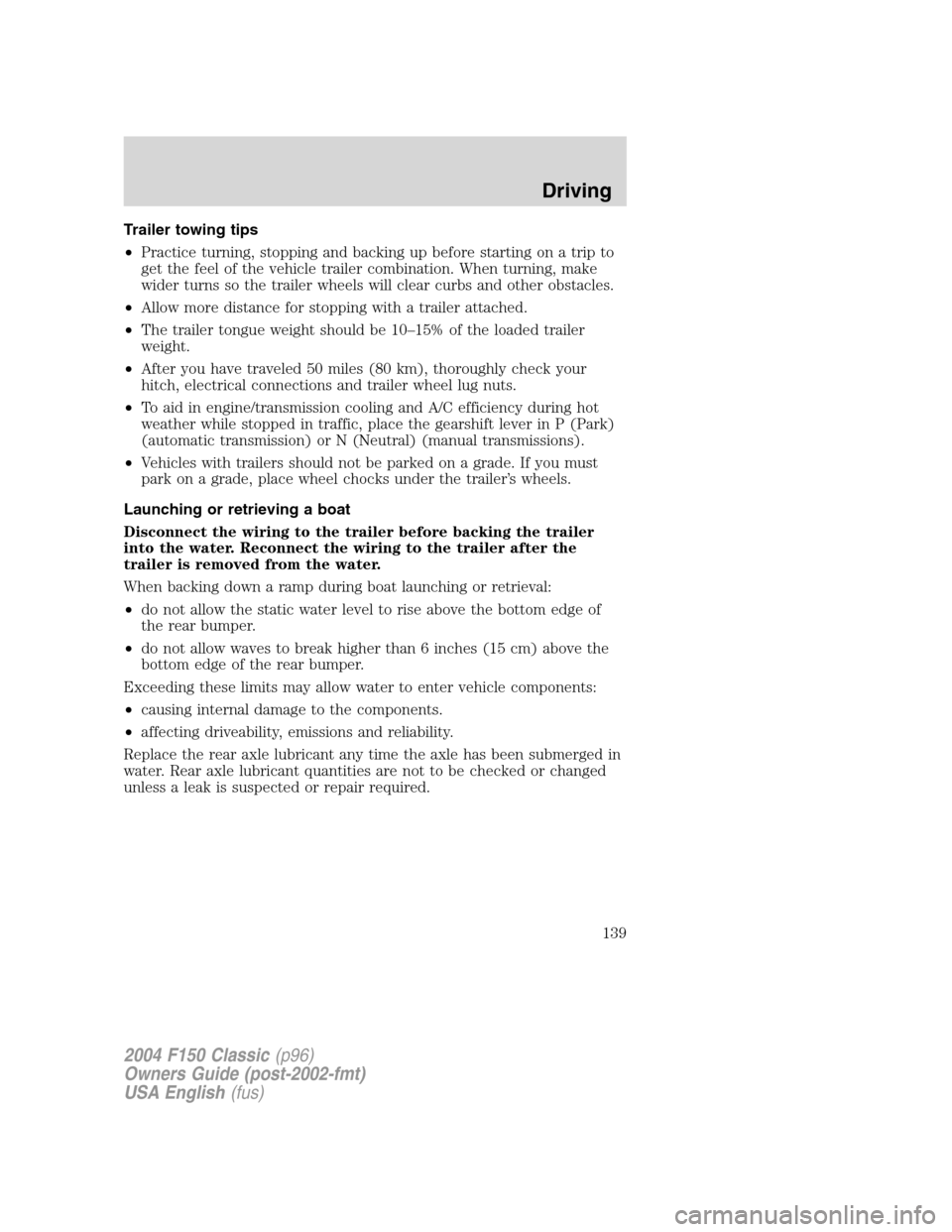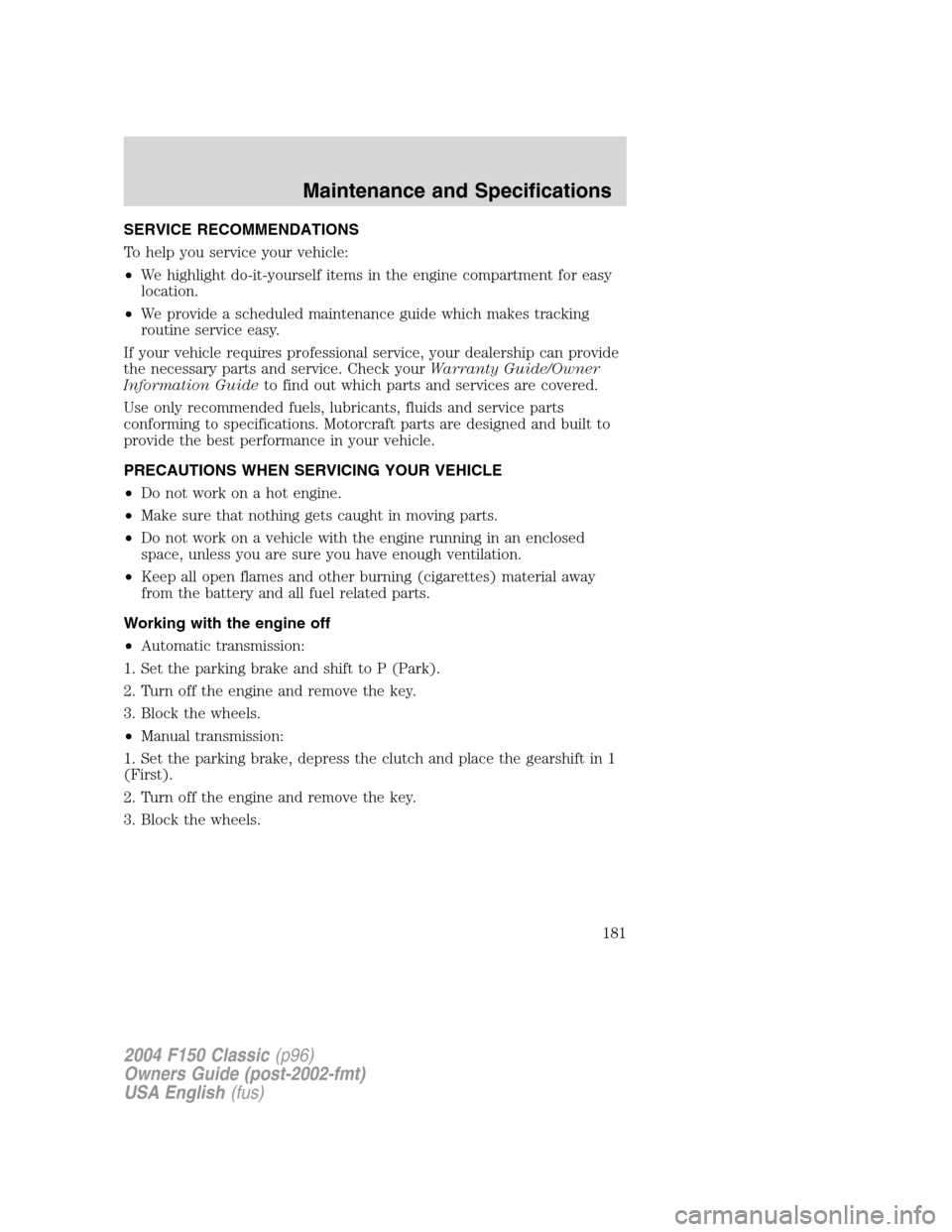Page 134 of 248

Do not exceed the GVWR or the GAWR specified on the
certification label.
Towing trailers beyond the maximum recommended gross trailer
weight exceeds the limit of the vehicle and could result in
engine damage, transmission damage, structural damage, loss of vehicle
control, vehicle rollover and personal injury.
Engine Rear axle ratio Maximum
GCWR - lbs.
(kg)Maximum
trailer weight -
lbs. (kg)
Regular Cab 4x2 w/automatic transmission
4.2L 3.31 9000 (4077) 4600 (2087)
4.2L 3.55 10000 (4536) 5700 (2585)
4.6L 3.08 10000 (4536) 2000 (907)
4.6L 3.31 10500 (4763) 6100 (2767)
4.6L 3.55 11500 (5216) 7100 (3221)
5.4L 3.73 13500 (6123) 8400 (3810)
Engine Rear axle ratio Maximum GCWR
- lbs. (kg)Maximum
trailer weight -
lbs (kg)
Regular Cab 4x2 w/manual transmission
4.2L 3.08 6500 (2944) 2000 (907)
4.2L 3.55 7800 (3538) 3500 (1588)
4.6L 3.08 6500 (2944) 2000 (907)
4.6L 3.31 7200 (3266) 2900 (1315)
4.6L 3.55 7800 (3538) 3500 (1588)
2004 F150 Classic(p96)
Owners Guide (post-2002-fmt)
USA English(fus)
Driving
134
Page 135 of 248
Engine Rear axle ratioMaximum
GCWR - lbs.
(kg)Maximum
trailer weight -
lbs. (kg)
Regular Cab 4x4 w/automatic transmission
4.2L 3.55 10000 (4536) 5400 (2449)
4.6L 3.31 10500 (4763) 5800 (2631)
4.6L
13.55 11500 (5216) 6800 (3084)
4.6L23.55 11000 (4990) 6300 (2858)
5.4L 3.73 13500 (6123) 8000 (3629)
116”tires217”tires
Engine Rear axle ratio Maximum GCWR
- lbs. (kg)Maximum
trailer weight -
lbs. (kg)
Regular Cab 4x4 w/manual transmission
4.2L 3.31 7200 (3265) 2500 (1134)
4.2L 3.55 7800 (3538) 3200 (1452)
4.6L 3.31 7200 (3265) 2500 (1134)
4.6L 3.55 7800 (3538) 3100 (1406)
Engine Rear axle ratio Maximum
GCWR - lbs.
(kg)Maximum
trailer weight -
lbs. (kg)
SuperCab 4x2 w/automatic transmission
4.2L 3.31 9000 (4077) 4500 (2041)
4.2L 3.55 10000 (4536) 5500 (2495)
4.6L 3.08 10000 (4536) 2000 (907)
4.6L 3.31 10500 (4763) 5900 (2676)
4.6L 3.55 11500 (5216) 6900 (3130)
5.4L 3.73 13500 (6123) 8200 (3719)
2004 F150 Classic(p96)
Owners Guide (post-2002-fmt)
USA English(fus)
Driving
135
Page 136 of 248

Engine Rear axle ratio Maximum GCWR
- lbs. (kg)Maximum
trailer weight -
lbs. (kg)
SuperCab 4x2 w/manual transmission
4.2L 3.08 6500 (2944) 2000 (907)
4.2L 3.55 7800 (3538) 3300 (1497)
4.6L 3.08 6500 (2944) 2000 (907)
4.6L 3.31 7200 (3266) 2600 (1179)
4.6L 3.55 7800 (3538) 3200 (1451)
Engine Rear axle ratioMaximum
GCWR - lbs.
(kg)Maximum
trailer weight -
lbs. (kg)
SuperCab 4x4 w/automatic transmission
4.6L 3.31 10500 (4763) 5500 (2495)
4.6L
13.55 11500 (5216) 6500 (2948)
4.6L23.55 11000 (4990) 6000 (2722)
5.4L 3.73 13500 (6123) 7800 (3538)
116”tires217”tires
Engine Rear axle ratio Maximum GCWR
- lbs. (kg)Maximum
trailer weight -
lbs. (kg)
SuperCab 4x4 w/manual transmission
4.6L 3.31 7200 (3266) 2300 (1043)
4.6L 3.55 7800 (3538) 2900 (1315)
Trailer frontal area considerations:
•Not to exceed towing vehicle frontal area without Class III trailer
towing package
•Not to exceed 60 square feet (5.52 square meters) with Class III
trailer towing package
Preparing to tow
Use the proper equipment for towing a trailer and make sure it is
properly attached to your vehicle. See your dealer or a reliable trailer
dealer if you require assistance.
2004 F150 Classic(p96)
Owners Guide (post-2002-fmt)
USA English(fus)
Driving
136
Page 139 of 248

Trailer towing tips
•Practice turning, stopping and backing up before starting on a trip to
get the feel of the vehicle trailer combination. When turning, make
wider turns so the trailer wheels will clear curbs and other obstacles.
•Allow more distance for stopping with a trailer attached.
•The trailer tongue weight should be 10–15% of the loaded trailer
weight.
•After you have traveled 50 miles (80 km), thoroughly check your
hitch, electrical connections and trailer wheel lug nuts.
•To aid in engine/transmission cooling and A/C efficiency during hot
weather while stopped in traffic, place the gearshift lever in P (Park)
(automatic transmission) or N (Neutral) (manual transmissions).
•Vehicles with trailers should not be parked on a grade. If you must
park on a grade, place wheel chocks under the trailer’s wheels.
Launching or retrieving a boat
Disconnect the wiring to the trailer before backing the trailer
into the water. Reconnect the wiring to the trailer after the
trailer is removed from the water.
When backing down a ramp during boat launching or retrieval:
•do not allow the static water level to rise above the bottom edge of
the rear bumper.
•do not allow waves to break higher than 6 inches (15 cm) above the
bottom edge of the rear bumper.
Exceeding these limits may allow water to enter vehicle components:
•causing internal damage to the components.
•affecting driveability, emissions and reliability.
Replace the rear axle lubricant any time the axle has been submerged in
water. Rear axle lubricant quantities are not to be checked or changed
unless a leak is suspected or repair required.
2004 F150 Classic(p96)
Owners Guide (post-2002-fmt)
USA English(fus)
Driving
139
Page 154 of 248

3. Fully insert the jack handle
through the bumper hole and into
the guide tube. The key and lock
will engage with a slight push and
counterclockwise turn. Some
resistance will be felt when turning
the jack handle assembly.
4. Turn the handle counterclockwise
until tire is lowered to the ground,
the tire can be slid rearward and the
cable is slightly slack.
5. Remove the retainer from the spare tire.
Tire change procedure
To help prevent the vehicle from moving when you change a tire,
be sure the parking brake is set, then block (in both directions)
the wheel that is diagonally opposite (other side and end of the
vehicle) to the tire being changed.
If the vehicle slips off the jack, you or someone else could be
seriously injured.
Refer to the instruction sheet (located with the jack) for detailed tire
change instructions.
1. Park on a level surface, activate
hazard flashers and set the parking
brake.
2. Place gearshift lever in P (Park)
(automatic transmission) or in the
reverse gear (manual transmission)
and turn engine OFF.
2004 F150 Classic(p96)
Owners Guide (post-2002-fmt)
USA English(fus)
Roadside Emergencies
154
Page 155 of 248
3. Block the diagonally opposite
wheel.
4. Obtain the spare tire and jack
from their storage locations.
5. Use the tip of the lug wrench to
remove any wheel trim.
6. Loosen each wheel lug nut
one-half turn counterclockwise but
do not remove them until the wheel
is raised off the ground.
7. Position the jack according to the following guides and turn the jack
handle clockwise until the wheel is completely off the ground.
When one of the rear wheels is off the ground, the transmission
alone will not prevent the vehicle from moving or slipping off the
jack, even if the transmission is in P (Park) or in the reverse gear
(manual transmission). To prevent the vehicle from moving when you
change the tire, be sure that the parking brake is set and the
diagonally opposite wheel is blocked. If the vehicle slips off the jack,
someone could be seriously injured.
2004 F150 Classic(p96)
Owners Guide (post-2002-fmt)
USA English(fus)
Roadside Emergencies
155
Page 181 of 248

SERVICE RECOMMENDATIONS
To help you service your vehicle:
•We highlight do-it-yourself items in the engine compartment for easy
location.
•We provide a scheduled maintenance guide which makes tracking
routine service easy.
If your vehicle requires professional service, your dealership can provide
the necessary parts and service. Check yourWarranty Guide/Owner
Information Guideto find out which parts and services are covered.
Use only recommended fuels, lubricants, fluids and service parts
conforming to specifications. Motorcraft parts are designed and built to
provide the best performance in your vehicle.
PRECAUTIONS WHEN SERVICING YOUR VEHICLE
•Do not work on a hot engine.
•Make sure that nothing gets caught in moving parts.
•Do not work on a vehicle with the engine running in an enclosed
space, unless you are sure you have enough ventilation.
•Keep all open flames and other burning (cigarettes) material away
from the battery and all fuel related parts.
Working with the engine off
•Automatic transmission:
1. Set the parking brake and shift to P (Park).
2. Turn off the engine and remove the key.
3. Block the wheels.
•Manual transmission:
1. Set the parking brake, depress the clutch and place the gearshift in 1
(First).
2. Turn off the engine and remove the key.
3. Block the wheels.
2004 F150 Classic(p96)
Owners Guide (post-2002-fmt)
USA English(fus)
Maintenance and Specifications
Maintenance and Specifications
181
Page 182 of 248
Working with the engine on
•Automatic transmission:
1. Set the parking brake and shift to P (Park).
2. Block the wheels.
•Manual transmission:
1. Set the parking brake, depress the clutch and place the gearshift in N
(Neutral).
2. Block the wheels.
Note:Do not start your engine with the air cleaner removed and do not
remove it while the engine is running.
OPENING THE HOOD
1. Inside the vehicle, pull the hood
release handle located under the
bottom of the instrument panel.
2. Go to the front of the vehicle and
release the auxiliary latch that is
located under the front center of
the hood.
3. Lift the hood until the lift
cylinders hold it open.
BRAKE
HOOD
2004 F150 Classic(p96)
Owners Guide (post-2002-fmt)
USA English(fus)
Maintenance and Specifications
182